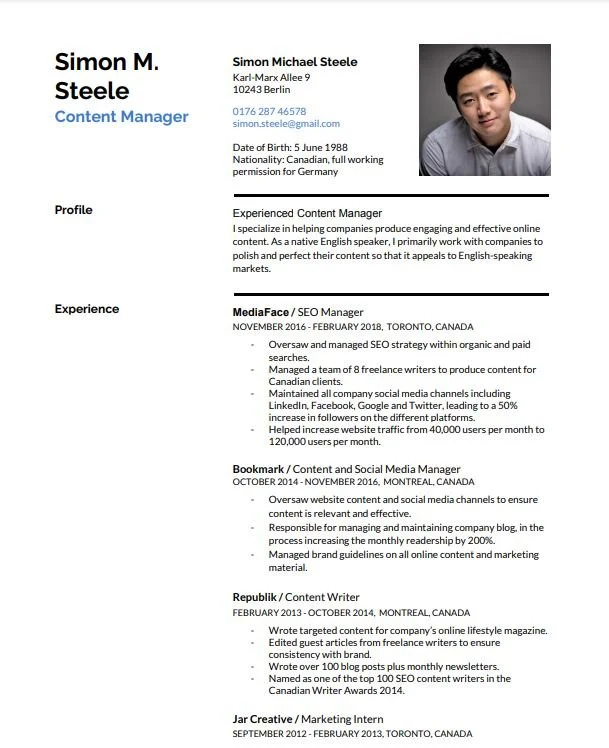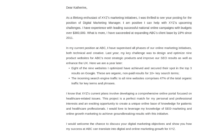Navigating the job market in a new country can feel a bit like learning a new language itself, especially when it comes to presenting your professional experience. If you are setting your sights on a career opportunity in Germany, you’ve likely realized that their approach to résumés, or CVs as they’re commonly known in Europe, has its own unique flavour. While you might be accustomed to a more concise, experience-focused document, German employers often expect something a little different, even when the application is submitted entirely in English.
Understanding these cultural nuances is key to making a great first impression. An Anglo-Saxon CV simply won’t cut it without some adjustments to align with German expectations. This is precisely where a well-structured german cv template in english becomes an invaluable asset, ensuring your application speaks the right professional language, regardless of the actual words used. It helps you include all the necessary information without sacrificing clarity or professional appeal, bridging the gap between what you’re used to and what German companies anticipate.
Decoding the German CV Format: Key Differences
When you start to explore what makes a German CV unique, you’ll quickly notice a few distinct characteristics that set it apart from its North American or even British counterparts. The fundamental difference lies in the level of detail and the specific personal information typically included. German employers tend to value a comprehensive, factual, and chronologically ordered document that leaves very little to interpretation. It’s less about creative flair and more about presenting your life story and career progression in a clear, unambiguous timeline.
One of the most immediate and striking differences for many applicants is the inclusion of a professional photo. While this might be a no-go zone for discrimination reasons in some countries, it’s a standard expectation in Germany, often placed prominently at the top right of the CV. Alongside the photo, you’ll also typically include your date of birth, place of birth, nationality, and sometimes even marital status. These details are considered standard personal information in German applications, aiming to provide a complete picture of the applicant from the outset.
Beyond personal details, the structure of the German CV is highly emphasis on chronological order. Your professional experience, education, and even language skills are presented in reverse chronological order, starting with your most recent role or qualification. Each entry should clearly state the dates, the name of the institution or company, your role or degree, and a concise bullet-point list of your responsibilities and achievements. The focus here is on tangible facts and verifiable information rather than elaborate descriptions or highly subjective statements.

Furthermore, sections dedicated to “Skills and Competencies” are often more detailed, categorizing technical skills, software proficiency, and language abilities with clear levels of fluency (e.g., native, fluent, advanced, basic). Extracurricular activities, volunteer work, and relevant hobbies are also commonly included, especially if they demonstrate transferable skills or a well-rounded personality. The entire document is usually signed and dated at the very end, underscoring its formal and official nature, even when submitted digitally.
Elements of a Typical German CV
- Professional Photo: Essential and usually placed prominently.
- Personal Details: Full name, address, contact information, date of birth, place of birth, nationality, and marital status.
- Professional Experience: Listed in reverse chronological order with clear dates, company names, roles, and key responsibilities/achievements.
- Education: Academic qualifications, degrees, and institutions, also in reverse chronological order.
- Skills and Competencies: Detailed breakdown of technical skills, language proficiency (with levels), and other relevant abilities.
- Certificates and Training: Any relevant professional development or qualifications.
- Interests/Hobbies: Optional, but can add personality if relevant.
- Signature and Date: A formal closing, even for digital applications.
Crafting Your German CV in English: Practical Tips
Once you understand the structural expectations of a German CV, the next step is to translate these requirements into a compelling document in English. The key here is to maintain the German preference for clarity, conciseness, and factual presentation, while utilizing clear, professional English. Avoid overly informal language or slang, even in a conversational context, as German business culture often appreciates a more direct and formal tone in written communication. Proofreading is absolutely critical; even a minor grammatical error can detract from your professional image.
When describing your professional experience, think about the impact you’ve made rather than just listing duties. Use strong action verbs and quantify your achievements whenever possible. For example, instead of “Managed projects,” consider “Successfully managed 10+ projects, resulting in a 15% increase in efficiency.” Even though the application is in English, German recruiters will appreciate the precision and data-driven approach. Tailor each application by highlighting skills and experiences most relevant to the specific job description, showing that you’ve done your homework and are genuinely interested in that particular role.
Don’t forget the importance of the cover letter. In Germany, the cover letter (Anschreiben) is not just an introduction; it’s an integral part of your application, designed to complement your CV by explaining your motivation for applying and why you are the best fit for the role. It should be concise, persuasive, and directly address the specific requirements of the job posting. While your german cv template in english provides the factual backbone, the cover letter adds the personality and context that compels a recruiter to learn more about you.
Finally, remember to gather all relevant supporting documents, such as copies of university degrees, professional certificates, and employment references (Zeugnisse). These are often requested alongside your CV and cover letter, sometimes even in the initial application phase. Presenting a complete and well-organized application package from the outset demonstrates your attention to detail and professionalism, qualities highly valued in the German workplace. Consistency in formatting across all documents also leaves a strong impression of thoroughness.
Tips for a Winning German CV in English
- Be Precise and Factual: Emphasize quantifiable achievements and clear, concise descriptions.
- Maintain a Professional Tone: Even in English, a formal and direct style is preferred.
- Use a High-Quality Photo: Invest in a professional headshot; it makes a significant difference.
- Proofread Meticulously: Errors in grammar or spelling can seriously undermine your application.
- Tailor Each Application: Customize your CV and cover letter for every job, highlighting relevant skills.
- Prepare Supporting Documents: Have all academic and professional certificates ready for submission.
By investing time in understanding these differences and structuring your application accordingly, you significantly increase your chances of standing out in the competitive German job market. It’s not just about translating your existing resume; it’s about reformatting it to align with established professional norms and cultural expectations. A well-prepared document shows respect for the hiring process and demonstrates your ability to adapt, which are valuable traits in any professional environment.
Embracing these guidelines will ensure your professional journey begins on the right foot, making your qualifications and experience shine through in a format that German recruiters are familiar with and appreciate. Your commitment to presenting yourself professionally, in a way that resonates with local expectations, will undoubtedly open doors to exciting career prospects.
